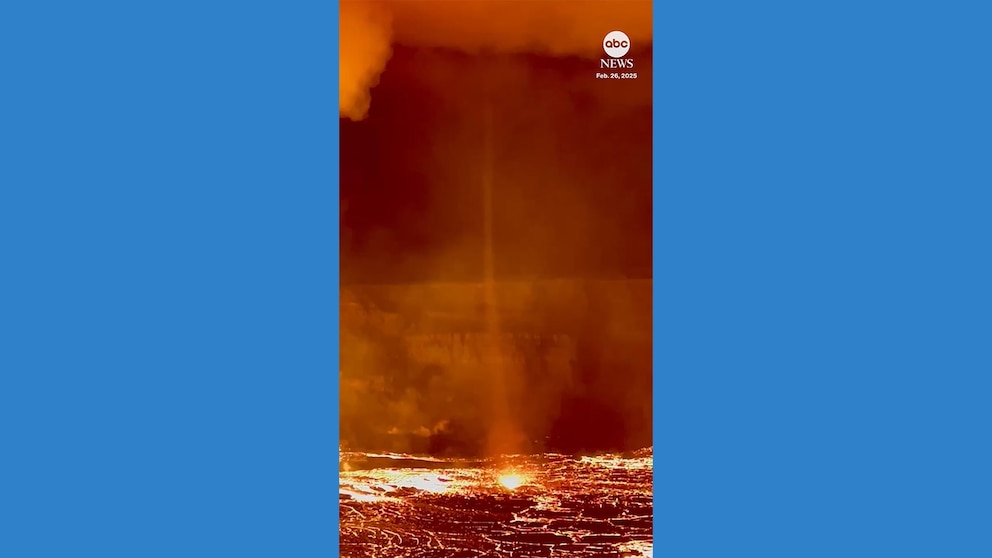Spectacular ‘Lavanado’ Phenomenon: A Rare Sight Above Kilauea’s Eruption
The recent observation of a spectacular ‘Lavanado’ phenomenon swirling above Kilauea volcano has captured the imagination of both scientists and spectators. This rare and mesmerizing event raises intriguing questions about the dynamics of volcanic activity and the natural world. As Kilauea continues to exhibit its fiery displays, the ‘Lavanado’ phenomenon stands out as a symbol of nature’s unpredictable beauty.
What is a ‘Lavanado’?
A ‘Lavanado’ is a relatively new term coined to describe a tornado-like formation that occurs in the vicinity of volcanic eruptions. Characterized by a swirling column of ash, gas, and volcanic debris, this phenomenon resembles a tornado but is distinctly linked to volcanic activity. The ‘Lavanado’ is formed when the intense heat from lava eruptions interacts with cooler air, creating a powerful updraft that picks up ash and other particulates, resulting in a visually stunning display.
This captivating event serves as a reminder of the dynamic processes occurring within our planet. The swirling column of debris can reach impressive heights, sometimes extending hundreds of feet into the sky, creating a striking contrast against the darkened landscape of the volcano. Observers have reported that witnessing a ‘Lavanado’ is both exhilarating and humbling, as it showcases the raw power of nature.
The Context of Kilauea’s Eruption
Kilauea, located on the Big Island of Hawaii, is one of the most active volcanoes in the world. Since 1983, it has experienced continuous eruptions, with its most recent activity beginning in late 2020. The ongoing eruptions have provided scientists with an unparalleled opportunity to study the behaviors of lava and the surrounding geological phenomena.
- Frequent Eruptions: Kilauea’s frequent eruptions offer a unique laboratory for volcanologists, who are keen to understand the processes that lead to events like the ‘Lavanado.’
- Volcanic Gases: The interaction of volcanic gases with the atmosphere plays a crucial role in forming these spectacular phenomena.
- Monitoring Technology: Advances in monitoring technology allow scientists to track changes in volcanic activity in real-time, enhancing our understanding of these dynamic systems.
How Does a ‘Lavanado’ Form?
The formation of a ‘Lavanado’ is a complex interplay of several factors:
- Heat Release: When lava erupts, it releases a tremendous amount of heat. This heat causes the surrounding air to warm up rapidly, creating a significant temperature difference.
- Updraft Creation: The heated air rises quickly, forming an updraft. If this updraft is strong enough, it can create a rotating column of air.
- Incorporation of Ash: As the updraft forms, it picks up volcanic ash and gas, which contributes to the visual spectacle of the ‘Lavanado.’ The swirling ash can create dramatic visuals that are both beautiful and dangerous.
The Scientific Significance of the ‘Lavanado’
The observation of ‘Lavanados’ is significant for several reasons. First, it enhances our understanding of volcanic eruptions and the processes involved. Scientists are particularly interested in how these phenomena affect the surrounding environment, including air quality and climate. Here are a few key scientific insights:
- Volcanic Ash Dynamics: Understanding how ash behaves during eruptions can help in predicting its impact on air travel and local ecosystems.
- Weather Patterns: The interaction between volcanic eruptions and weather patterns can lead to changes in local climates, making this an important area of study for climate scientists.
- Public Safety: Observing ‘Lavanados’ can aid in public safety measures by providing data on the potential hazards associated with volcanic eruptions.
Experiencing the ‘Lavanado’
For those fortunate enough to witness a ‘Lavanado,’ the experience is often awe-inspiring. As the ash and gases swirl above the volcano, the colors of the sunset can cast a breathtaking glow on the scene, transforming the eruption into a surreal landscape. Photographers and tourists flock to Kilauea to capture this extraordinary display, but safety remains a top priority.
Visitors are encouraged to follow guidelines provided by the Hawaiian Volcano Observatory and local authorities. Staying at a safe distance is crucial, as the conditions around active volcanoes can change rapidly. However, for those who adhere to safety protocols, the chance to see a ‘Lavanado’ is a once-in-a-lifetime opportunity.
Conclusion: A Window into Earth’s Power
The spectacular ‘Lavanado’ phenomenon, observed amidst Kilauea’s eruption, serves as a powerful reminder of the Earth’s dynamic and ever-changing nature. As scientists continue to explore the implications of such events, the fascination with volcanic activity only grows. Each ‘Lavanado’ captured not only tells a story of geological processes but also highlights the beauty and complexity of our planet.
As we look toward the future, the study of phenomena like the ‘Lavanado’ will undoubtedly lead to greater insights into our world, fostering a deeper appreciation for the forces that shape our environment. For both scientists and enthusiasts alike, the allure of Kilauea and its extraordinary displays will continue to inspire wonder and curiosity for generations to come.
See more Your Daily Weather



